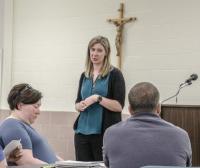For Many, Human Trafficking Bears A Familiar Face

Statistics don’t often evoke disturbing emotions. These did.
Only nine percent of the criminals involved in human trafficking are strangers to their victims. According to information Diocese of Evansville youth and young adult ministers learned during a May 8 meeting at the Catholic Center, 36 percent are victims’ family members; 27 percent are their boyfriends or girlfriends; family friends and employers make up lower percentages, but both are higher than strangers.
Just as disturbing are these two numbers: one-third and 48 hours; one-third of all runaways are never reported to the authorities, and practically every young runaway has contact with a human trafficker within 48 hours of striking out on their own.
Christina Wicks of Evansville shared these and other disturbing numbers with the group during an hour-long presentation: “Human Trafficking in Indiana: Identification, Recognition and Reporting.” Wicks serves as Region 9 Coordinator for the Indiana Trafficking Victims Assistance Program. Region 9 includes 10 counties in Southwest Indiana, all of them within our diocese: Daviess, Dubois, Gibson, Knox, Martin, Pike, Posey, Spencer Vanderburgh and Warrick.
She made it clear that human trafficking is occurring here … now.
One of the images she displayed showed a map developed by the Polaris Project, an organization that works to disrupt human-trafficking networks around the world. The map of the continental U.S. showed high trafficking activity in major metropolitan areas and along the U.S. interstate highway system. Rural areas with population densities higher than the upper Great Plains and “big sky” country also see a lot of activity on the map.
Indiana’s boundary outline is mostly invisible on the map because it’s covered by the colors of trafficking activity.
Wicks talked about a variety of factors that can make young people susceptible to victimization by human traffickers. Family dynamics, problems at home, issues with drug abuse and addiction; all can and do play roles. In the end, human predators key in on the vulnerabilities of their victims and trap them in terrible situations quickly.
Victims end up in the sex industry, or in massage parlors. They do domestic work, or work in restaurants or health and beauty jobs. They are farm, forestry and construction workers. They work in truck stops, and even in door-to-door sales.
“It’s usually in the summer that we have people, usually young people, come to our doors trying to sell us magazines,” Wicks said. “Talk to them about the work they’re doing and where they’ve been. If they unsure of their whereabouts – or where they have been recently – and/or if they are very pushy about making sales, you should alert someone because you may be witnessing human trafficking.”
Wicks said she has helped form the Southwest Indiana Regional Coalition Against Trafficking. SIRCAT meets on the fourth Wednesday of every month, usually at the central library in downtown Evansville. She said the group has a basic mission: “We want everyone to be trained to recognize the victims of human trafficking when they encounter them.”
Wicks provided multiple ways to report possible trafficking. In cases that appear imminently dangerous or harmful, she said to just dial 911. The Indiana Department of Child Services hotline is 800-800-5556. The National Human Trafficking Hotline is 888-373-7888. You also can text “help” or “info” to 233733. In our area, the We-Tip Hotline has earned recognition as the most-used hotline of its type in the country. You can report suspected human trafficking there by calling 800-782-7463.




